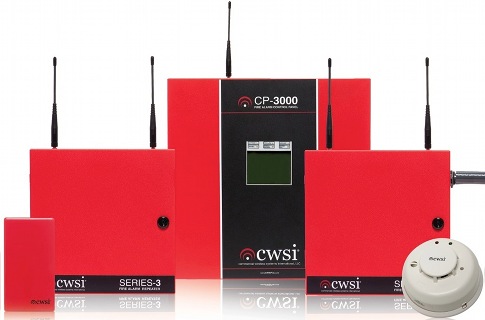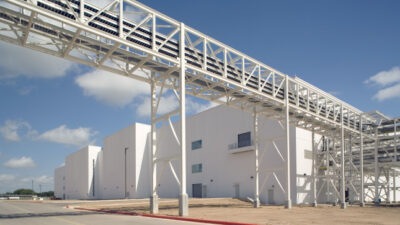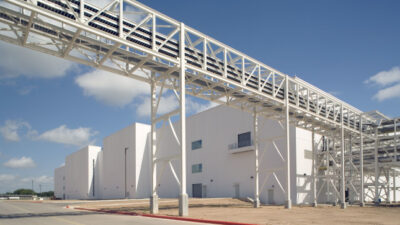Fire protection engineers should explore the costs, benefits, history, technology, and code compliance aspects of low-power radio wireless fire alarm systems and wireless smoke alarms.

Learning objectives
1. Understand the basics of wireless fire alarm systems.
2. Learn to calculate the cost of wired versus wireless systems.
3. Become familiar with NFPA 72.
Wireless fire alarms are often confused with wired fire alarm systems so often, we forget that it is “wireless” and not “wire-free.” Understanding this basic difference will help you calculate the savings associated with a wireless fire alarm system. In a wireless application, the notification devices currently must be wired to the wirelessly controlled and supervised notification appliance circuits (NAC) booster panels, thus reducing the associated conduit/cabling costs by locating horn/strobes very close to the wireless NAC/booster panels.
Each application, wireless or hardwired, requires a careful study to determine the suitability and consider the associated costs. It is never always one or the other; each application has its associated costs versus savings.
Wireless fire alarm systems are varied in their cost savings. In difficult applications where you cannot install cable (or where you can install only limited amounts of cable), you will see major labor cost savings. This might include applications that would require a significant amount of exposed conduit, painting, patching, and texturing to bring the premises back to pre-installation conditions (typical of retrofit-type applications). The savings become even greater in applications where you’d have to trench a site and incur the costs associated with concrete/asphalt cutting, trenching, backfilling, compressing, and resurfacing to original conditions. In these applications, wireless is an easy choice due to its instant savings and speed of installation. Particularly where asbestos or lead paint are present, or in historic buildings, wireless can reduce hazardous conditions exposure and improve the aesthetic appeal of historic properties.
In other applications, there is significant savings when speed of installation is important to the client. In retrofit applications such as a hotel, motel, or condo, you can install the detection devices faster than the maid can clean the room. Newer technology allows “tandem” smoke operation in residential properties that have multiple smoke detectors in a common apartment, condo, or large hotel room. A wireless system for a 100-room property with a single building site can be installed in 7 to 10 days with testing. For a hardwired fire alarm application, installation could take upward of 4 to 6 weeks (assuming a two-man installation team). Of course, when an active fire alarm system is not in place, there is even more savings if you factor in the wasted (nonrecoverable) labor expense of fire watch during a retrofit (assuming a hardwired installation/retrofit versus a wireless application). Five days of fire watch is standard in wireless systems; 30 days of fire watch is typical in hardwired systems.
NFPA 72: National Fire Alarm and Signaling Code, requires fire alarm products to be listed for the intended purpose/applications. Listing/approving organization/agencies such as the California State Fire Marshal, New York Fire Department, Federal Communications Commission (FCC), UL, and FM Global are important assurances that the wireless product you choose is the caliber and offers the reliability you demand as a specifying engineer.
The larger the systems, the more cost-effective a wireless fire alarm system can become. This is because you do not necessarily need data gathering panels, zone expanders, and loop cards, which are typical of a larger hardwired system. In the wireless fire alarm arena, some wireless fire alarm panels out of the box can handle 1000+ detection devices without the need to ever expand the panel. Wireless fire alarms require no terminal boards/loop cards to terminate wires to; thus the client realizes the cost savings of no conduit, no wire, no wire pull, no trim, no terminations, and no troubleshooting associated with grounds, ground faults, polarity issues, opens, and so on. In areas of the country that are lightning-prone, wireless systems can all but eliminate the associated lightning damage that can cause havoc to wired fire alarm systems. Wireless fire alarm materials (Figure 1) are usually more expensive, and the installation labor is typically less expensive.
Technology
Common wireless technologies include radio frequency, optical and sonic with radio frequency being employed in fire alarm systems. Various frequencies and modulation types are used in radio frequency communications. All are regulated by the FCC. Fire systems using low-power radio frequency communications operate at levels below the threshold that requires FCC licensing. To transmit informative signals, various methods of modulation are used: frequency modulation, amplitude modulation, phase shifting, amplitude shifting, frequency spreading (spread spectrum), ultra-wideband modulation, and combinations of these.
Spread spectrum is commonly used for communications in wireless fire alarm systems as it is more immune to noise and interference and provides for more secure communications. Within spread spectrum, variations exist for frequency hopping, direct sequencing, time hopping, and chirp methodologies. Frequency hopping spread spectrum modulation shifts a carrier signal among many frequency channels in a pseudo-random sequence known to both transmitter and receiver. Once synced, the transmitter and receiver communicate in a secure, robust pathway. The frequency hopping spread spectrum radio frequency (RF) protocol used by wireless fire alarm system manufacturers is also the chosen RF technology for the U.S. military, NASA, and other high-security organizations requiring the most secure and reliable RF protocol.
Designers and installers of wireless systems perform an RF survey as part of their pre-installation phase. These surveys are used to determine the location of repeaters to account for building features and other sources of RF interference to ensure that the pathways exist for the system to be installed. If interference is found, then repeaters can be relocated or added to compensate for the attenuated signal.
Code compliance
Wireless fire alarm systems and code compliance are easy to achieve once you understand the applicable code requirements. Specific requirements have been in NFPA 72 and its predecessor standards since 1987; the current standard is NFPA 72-2013. Wireless fire alarm systems are referred to as low-power radio (wireless) fire alarm systems in this code. These systems are required to comply with all of the requirements that wired fire alarm systems comply with, except as modified by circuits and pathway designations and special requirements found in NFPA 72.
Circuits and pathways
Circuits and pathways as used in NFPA 72 are circuits, conductors, optic fibers, radio carriers, or other means connecting two or more locations. These interconnections between two or more locations are achieved through a pathway. The performance and survivability characteristics of pathways are outlined in Chapter 12 of NFPA 72.
The pathway classification describes performance characteristics and capabilities to continue to operate during abnormal conditions. Various fault conditions are used as the criteria to establish a pathway designation and level of performance. Pathways are designated as Class A, B, C, D, E, or X. The pathway designations recognize that wireless fire alarm system pathways are not subject to the ground faults and open circuits like wired circuits are. Figure 2 shows an example of a redundant pathway available in some wireless fire alarm systems.
Some of the class designations that could be used for wireless systems include Class A, C, E, and X. Class A pathways are not disabled due to a ground fault or short circuits. Class C pathways include wireless LAN systems where end-to-end communication is verified but not the integrity of the individual pathway. Class E pathways are not monitored for integrity but may include monitoring by ability to use the function controlled at the end of the pathway. Class X pathways include a redundant path or the ability to operate past a single open or short circuit—conditions that affect the path are detected and annunciated. The significance of this as it relates to wireless fire alarm systems is that once the pathway classification is designated, then the fault tolerance is known.
It should be noted that changes for the NFPA 72-2013 include changes to pathway classifications that will impact wireless radio fire alarm systems. Specifically, clarification was added in the form of exceptions to the pathway classifications designating when requirements do not apply to nonconductive pathways (e.g., wireless or fiber).
Some of the special requirements found in NFPA 72 for wireless fire alarm systems include:
- Listing
- Power supply
- Alarm signals
- Monitoring for integrity
- Output signals for receiver/control
- Acceptance testing.
Listing
Wireless fire alarm systems are required to be specifically listed. UL Standard 864, Standard for Control Units and Accessories for Fire Alarm Systems, is used for wired and wireless radio fire alarm systems. The UL standard has a section that specifically addresses low-power RF signaling common performance and monitoring for integrity of protected premises units/systems. Likewise, FM Global Standard 3010, Approval Standard for Fire Alarm Signaling Systems, is used by FM for approval of low-powered wireless systems. A few manufacturers have received UL or FM approvals for their systems. It should also be noted that manufacturers of these systems also must comply with the low-power requirements of Title 47, Code of Federal Regulations, Part 15.
Power supply
Batteries are permitted to serve as the sole power supply of wireless systems. Manufacturers of these wireless fire alarm transmitter devices that use batteries as the sole power supply are required to design the system so each transmitter serves one device that is uniquely identifiable, size the battery with sufficient capacity to operate normally for at least 1 year, transmit a distinctive battery depletion signal before the battery has reached the level required to transmit an alarm signal, generate a trouble signal at the fire alarm control unit when a battery catastrophically fails, and have no impact on other transmitters when a transmitter battery fails.
A change for NFPA 72-2013 includes requiring an audible trouble signal associated with signaling the depletion or failure of the primary battery of a wireless system to automatically resound at the protected premises every 4 hours or less until the depletion signal is restored to normal.
Alarm signals
When an alarm-initiating device is actuated, code requires an automatic transmission to be sent. The signal processing between the time the initiating device is actuated and the control panel displays the alarm cannot exceed 10 seconds. Transmitters are required to repeat the alarm transmission every minute or less until the initiating device is restored. This section requires the manufacturers’ control equipment to latch alarm signals until manually reset and also establishes signal priorities for manufacturers.
Changes for NFPA 72-2013 include changes to alarm signals that impacts wireless radio fire alarm systems. Specifically, clarification was added in the form of a modifier on the type of alarm signals required to latch. Only fire alarm signals will be required to latch until manually reset. Additional language was placed into the annex to clarify which signals are required to latch.
Monitoring for integrity
Manufacturers are required to use transmission methods that are resistant to misinterpretation of simultaneous transmission and to interference. This is examined as part of the product listing. To ensure the integrity and capability of the signal pathway, the control equipment is required to poll the transmitters every 200 seconds or less (note that some special exceptions, which will expire on June 30, 2013, extend the polling period). If a transmitter fails the pathway, verification of a fault is generated. If a fault is generated, it cannot cause an alarm signal. If a transmitter is removed, a supervisory signal is generated on the control equipment. If signal interference is detected for 20 or more consecutive seconds, then an audible/visual trouble signal is annunciated on the control equipment.
Output signals for receiver/control
Low-powered radio fire control equipment that initiates fire control functions or notification appliances wirelessly is required to comply with specific requirements that regulate power supplies, monitoring for integrity, response time, signal repeating, and output latching until manually reset.
Acceptance testing and reacceptance testing
In addition to the standard acceptance testing criteria, wireless systems also require the following to verify wireless protection system operation:
- The manufacturer’s designated representative performs an initial testing phase and verifies correct operation.
- The existence of alternative communications paths is confirmed between the wireless control unit and peripheral devices used to establish alarm and trouble initiation, indication, control, and annunciation.
- Batteries are checked in the system monthly unless the control unit checks all batteries and all components daily.
Smoke alarms and wireless technology
A smoke alarm is not the same thing as a smoke detector. A smoke detector requires a connection to a control panel to provide notification. A smoke alarm (also known as a single or multiple station alarm) responds to smoke as a stimulus and produces alarm notification without external control equipment. Each device includes a smoke chamber, alarm sounder, power supply, and associated electronics allowing it to sense smoke and initiate an audible alarm. Some also provide visible alarm notification.
The primary technological differences between a smoke alarm and a smoke detector are how the devices are interconnected and the power source. Interconnection of smoke alarms is required for all new installations where more than one smoke alarm is required within a sleeping unit, suite, dwelling, or house. Interconnected devices activate the audible or audible/visual notification feature in each device in unison, resulting in a simultaneous alarm.
Hardwired smoke alarms are interconnected through wiring with other smoke alarms. Wireless smoke alarms also can be interconnected to other wireless smoke alarms through RF signaling pathways. This interconnect enables them to produce a simultaneous audible alarm signal upon activation of any smoke alarm. As with most wired interconnected smoke alarms, most wireless interconnected smoke alarms are not required to be supervised. As shown in the floor plan, the primary benefit of using interconnected wireless smoke alarms is the interconnection itself. A secondary benefit is the elimination of the wiring between devices. Hardwired and wireless smoke alarms can provide earlier warning to escape because of the common alarm notification that interconnection provides throughout the unit.
Lynn Nielson is a registered professional fire protection engineer and a past president of the Society of Fire Protection Engineers’ (SFPE) Southern Nevada Chapter. He is a member of NFPA, the Technical Correlating Committee for Fire Alarm Systems, and the Technical Committee for Initiating Devices. Jim Avanzino retired from Siemens Industry Inc., where he was a regional manager. He is a member of SFPE’s Southern Nevada Chapter.



